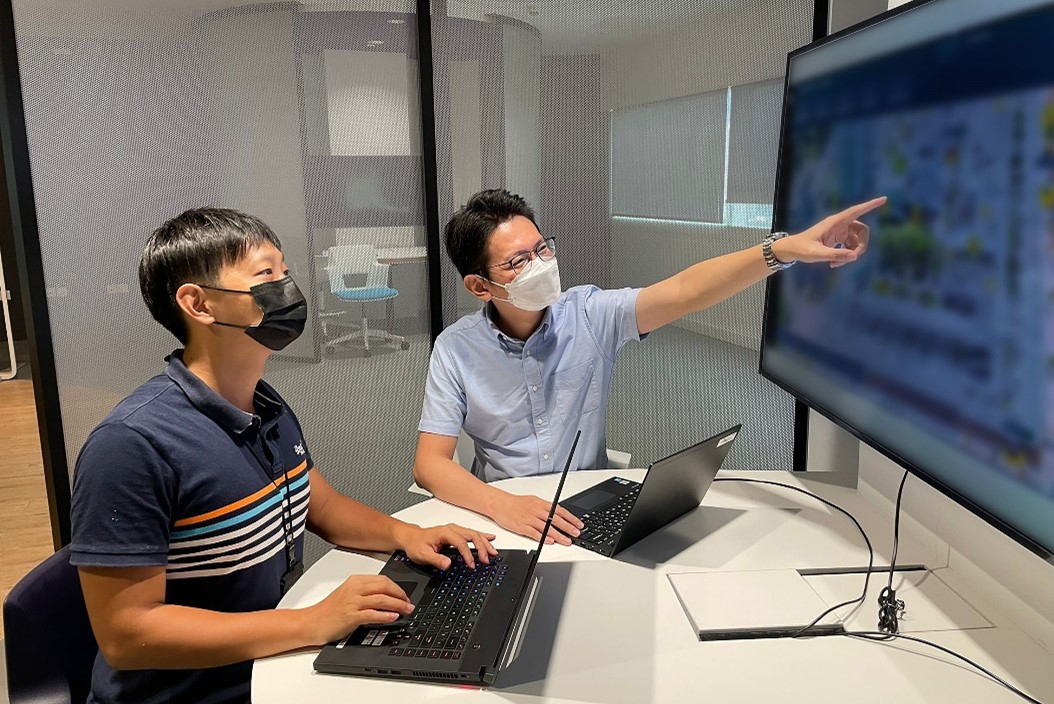Different robots are designed to serve different and specific purposes. What happens when the Home Team deploys a fleet of different autonomous robots for different operations? How do we drive synergy in the deployment, and operations integration to optimise efficiency and effectiveness?
The common robotics dashboard, HTX’s latest in development command and control system ensure that we have this in hand. It is able to deploy and control a wide range of different types of robots to multiple locations and on a variety of missions.
At the moment, Home Team officers can only control one robot with its own controller and the controller is not compatible with other robots. However, when the common robotics dashboard is fully implemented, officers will be able to control all the different types of robots that HTX has developed at the same time.

Rover-X checking fire equipment (Image Credit: HTX)
“As part of our overall robotics strategy, we are exploring the use of different types of robots for different roles, thus we are developing a variety of robots for a wide range of purposes,” said Ong Ka Hing, Deputy Director, HTX’s Robotics Automation and Unmanned Systems Centre of Expertise (RAUS CoE). “Without the common robotics dashboard, the Home Team’s user cognitive workload will be increased as they need many officers to operate different types of robots. The common robotics dashboard’s ability to enable officers to command multiple robots simultaneously will help officers focus on managing critical tasks.”
How the common robotic dashboard works
At the simulation demonstration of the common robotics dashboard, Chin Zhihao, Head of Ground Systems, RAUS CoE showed off the prowess of this new platform. Looking at the map of the deployment area, Zhihao was able to monitor the location of the robots as it patrols the environment. On the teleoperations page, he could see the video feed from the robots’ cameras and used the handheld controller to remotely operate the robot and its camera, while also looking at the satellite map which enabled him to see where the robot was. While that was happening, an alert popped up on the status bar, warning him of an anomaly detected by the robot, which can include the detection of unattended baggage or the presence of unauthorised persons in protected areas. A quick look into the events page lets him view the digital image of the anomaly, time stamp and information on the source of the detection.

RAUS engineers Goh Boon Kiat and Chin Zhihao working on the common robotics dashboard (Image Credit: HTX)
Zhihao explained that the common robotics dashboard’s fleet management system will allow him to command multiple robots efficiently. “The fleet management system can optimise the patrol route by adjusting the robot schedule to evenly distribute all available robots to cover different areas. There is also a traffic management system to deconflict the robots’ routes,” Zhihao said.
The common robotics dashboard can integrate control for HTX robots that are already in active deployment. This includes Xavier, which was used to patrol Toa Payoh Central to support public officers in enhancing public health and safety and the Rover-X.
HTX’s new high tech canine
Rover-X is developed to move through a variety of difficult terrain and overcome obstacles. As opposed to a robot with wheels or tracks, Rover-X is a robotic dog with four legs, which gives it much greater mobility as it is able to go up and down stairs and curbs.
“Rover-X’s mobility gives it a lot more potential for different missions and applications,” said Goh Boon Kiat, Engineer in RAUS CoE, who worked on Rover-X.
Rover-X is also ideal for use in high-risk missions. For example, imagine there’s a chemical plant that might have a hazardous gas leak. Instead of sending emergency responders from the Singapore Civil Defence Force (SCDF) to the plant to find out where the gas leak is but now through the use of Rover-X, SCDF can send the robot to the chemical plant instead, where it can sniff out noxious gases safely with the gas sensor on its body.

Boon Kiat with Rover-X (Image Credit: HTX)
Boon Kiat has a personal passion for Rover-X because he feels it will have significant benefits for Home Team officers. “Our Home Team officers face high risk operations,” said Boon Kiat. “I remember once watching a video where it showed SCDF officers having to approach a taxi on fire that exploded. Rover-X can be used to help Home Team officers on dangerous missions, helping them manage their real day-to-day risks. I’m passionate about Rover-X because it’s part of our strategy to make missions for Home Team frontline officers safer.”
An agile approach to developing robots and common robotics dashboard
RAUS CoE uses an agile method to test and refine its robots and common robotics dashboard. Seeking inputs from different users, a prototype is then developed for users to trial in operational environment. After gathering feedback on the prototype, the engineers make improvements for the next version of the systems. “To ensure user experience and fulfilling the operational needs, we adopted an agile development method that breaks the development into multiple iterations,” Zhihao said. “At the end of each iterations, we rolled out a working prototype for the users to trial it in an operational environment. This allows us to solicit user feedback early to enhance the design throughout the development to better meet operation requirements.”
Rover-X and the common robotics dashboard were showcased at the Milipol Asia-Pacific – TechX Summit exhibition held at the Marina Bay Sands convention centre from 3-5 April 2024.

